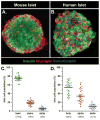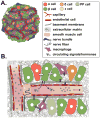Signals in the pancreatic islet microenvironment influence β-cell proliferation
- PMID: 28880471
- PMCID: PMC5679109
- DOI: 10.1111/dom.13031
Signals in the pancreatic islet microenvironment influence β-cell proliferation
Abstract
The progressive loss of pancreatic β-cell mass that occurs in both type 1 and type 2 diabetes is a primary factor driving efforts to identify strategies for effectively increasing, enhancing or restoring β-cell mass. While factors that seem to influence β-cell proliferation in specific contexts have been described, reliable stimulation of human β-cell proliferation has remained a challenge. Importantly, β-cells exist in the context of a complex, integrated pancreatic islet microenvironment where they interact with other endocrine cells, vascular endothelial cells, extracellular matrix, neuronal projections and islet macrophages. This review highlights different components of the pancreatic microenvironment, and reviews what is known about how signaling that occurs between β-cells and these other components influences β-cell proliferation. Future efforts to further define the role of the pancreatic islet microenvironment on β-cell proliferation may lead to the development of successful approaches to increase or restore β-cell mass in diabetes.
Keywords: beta-cell; islets.
© 2017 John Wiley & Sons Ltd.
Conflict of interest statement
No conflicts of interest, financial or otherwise, are declared by the author(s).
Figures





References
Publication types
MeSH terms
Grants and funding
- P60 DK020593/DK/NIDDK NIH HHS/United States
- UC4 DK104211/DK/NIDDK NIH HHS/United States
- U01 DK072473/DK/NIDDK NIH HHS/United States
- UC4 DK112232/DK/NIDDK NIH HHS/United States
- U01 DK089572/DK/NIDDK NIH HHS/United States
- R24 DK106755/DK/NIDDK NIH HHS/United States
- R24 DK090964/DK/NIDDK NIH HHS/United States
- R01 DK097829/DK/NIDDK NIH HHS/United States
- F30 DK097921/DK/NIDDK NIH HHS/United States
- UC4 DK108120/DK/NIDDK NIH HHS/United States
- T32 GM007347/GM/NIGMS NIH HHS/United States
- I01 BX000666/BX/BLRD VA/United States
- R01 DK094199/DK/NIDDK NIH HHS/United States
- P30 DK020593/DK/NIDDK NIH HHS/United States
LinkOut - more resources
Full Text Sources
Other Literature Sources

